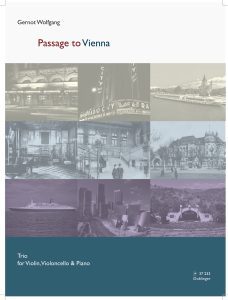PASSAGE TO VIENNA (2012)
for violin, violoncello & piano
Doblinger Music Publishers, Vienna (catalog # 37 233)
09/14/2012 at Harbor College in Wilmington, CA by the Saguaro Trio
Opus Tomorrow - the commissioning program of the South Bay Chamber Music Society
Gernot Wolfgang, VIENNA AND THE WEST (2019), Albany Records CD TROY 1760
______________________________
DOWNLOAD PROGRAM NOTES (English)
DOWNLOAD PROGRAM NOTES (German)




(click on images of excerpts to enlarge)
Stream on Spotify
Stream on YouTube
More information about the recording of Passage To Vienna on the album VIENNA AND THE WEST
______________________________
Purchase the sheet music for Passage To Vienna at:
Theodore Front Musical Literature, Inc.
sheetmusicplus.com
Reviews:
“Passage to Vienna“, for piano trio, instantly reminded me of Piazzolla. However, I hasten to add, this is a much more accomplished piece than any I’ve experienced from Piazzolla. But the flavor is similar – at first. It doesn’t take long for Wolfgang to venture out into his own, very unique territory, proving again what a skillful, inventive composer he is. There is a sensational combination of moods here, from musically singing, lyrical passages, shifting to energetic, rhythmic propulsive ones. And I am once again struck with the superb musicianship of these performers (especially pianist Joanne Pearce Martin) and the excellence of the recorded sound.”
David Rowe, Classical CD Reviews
“Passage to Vienna” for piano trio, the second piece on the album, is a story told in fragments, and exemplifies why this unique fusion works so well. It opens with a beautifully flowing, seductive melody in the piano and repeated unison in the strings. Groovy rhythms precede a jazzy violin solo, done with flair and style. We are then transported to Vienna at the turn of the century, and non-linearity takes over along with strong cinematic colours. The mood shifts back to America toward the end and the opening theme comes back but this time it is coloured with dissonance. Another jazzy violin solo, with added country-style motives and propelling rhythms in the piano bring this piece to a conclusion. The textures are simply divine.”
Ivana Popovic, The Whole Note
“The piano trio Passage to Vienna is a more serious work, dealing with the Old World/New World dialectic that has given us so many great works of art, from Henry James to Heitor Villa-Lobos. This is Anton Webern played late at night, after Dave Brubeck and Paul Desmond have finished their final set.”
Dean Frey, Music for Several Instruments
“The album continues to impress with pieces that very clearly demonstrate Californian and Viennese influences in ways that surprisingly complement each other. Standouts include “Passage to Vienna” for piano trio, in which the composer takes us from contemporary America back to early 1900s Vienna (think Schoenberg and Webern) and back again.”
Jeffrey Palmer, CutCommon
“Blends of early 20th Century Austrian masters of the Second Viennese School can be heard in the dissonance and harmonic structures in the piano trio Passage to Vienna (2012). That component is at the center of the work that opens with a piano thematic statement that then becomes a jaunty violin line with jazz inflections. The jazzy syncopations that begin to appear in the piano add some great forward drive as the improvisatory sound of the violin soars above it. The blocks of sound and clusters that begin to pile up at the center are a nod to Wolfgang’s Austrian musical roots, but maintains a sense of extended jazz harmonies which “come back” from their European visit slightly more dissonant than before.”
Steven Kennedy, Cinemusical
“Passage to Vienna” charts a stylistic journey to the city of Schoenberg, Berg and Webern and then back to America. The opening piano theme sounds weirdly like Mussorgsky’s Pictures for a brief moment and this rather Slavic element permeates some of the music. Wolfgang’s mastery of the ‘pizzicato bass’ is also evident here as the music is irradiated by jazz before it calms for slow refractive reflections of twelve-tone, notably from the anchoring piano. This in turns generates a bop mood, the cello-as-bass adding to the mix once again and creating driving, resinous fun”.
Jonathan Woolf, Musicweb-International